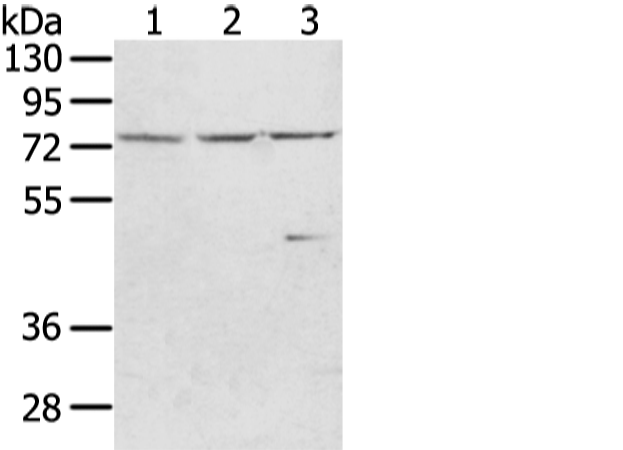

| WB | 1/200-1/1000 | Human,Mouse,Rat |
| IF | 咨询技术 | Human,Mouse,Rat |
| IHC | 1/20-1/100 | Human,Mouse,Rat |
| ICC | 技术咨询 | Human,Mouse,Rat |
| FCM | 咨询技术 | Human,Mouse,Rat |
| Elisa | 1/1000-1/2000 | Human,Mouse,Rat |
| Aliases | DKCB3; TCAB1; WDR79 |
| WB Predicted band size | 59 kDa |
| Host/Isotype | Rabbit IgG |
| Antibody Type | Primary antibody |
| Storage | Store at 4°C short term. Aliquot and store at -20°C long term. Avoid freeze/thaw cycles. |
| Species Reactivity | Human, Rat |
| Immunogen | Fusion protein of human WRAP53 |
| Formulation | Purified antibody in PBS with 0.05% sodium azide and 50% glycerol. |
+ +
以下是关于WRAP53抗体的3篇代表性文献,涵盖其功能、应用及疾病相关研究:
1. **文献名称**: "WRAP53 is involved in the posttranslational regulation of human telomerase reverse transcriptase"
**作者**: Mahmoudi S, et al.
**摘要**: 该研究揭示了WRAP53蛋白通过调控端粒酶(hTERT)的稳定性在维持端粒功能中的作用,并利用特异性WRAP53抗体证实其在癌细胞中的定位与hTERT的相互作用,为癌症治疗提供潜在靶点。
2. **文献名称**: "WRAP53 promotes cancer cell survival and is a potential target for cancer therapy"
**作者**: Hosseini A, et al.
**摘要**: 通过免疫组化(使用WRAP53抗体)和基因沉默实验,研究发现WRAP53在多种癌症中高表达,并促进肿瘤细胞抗凋亡能力,提示其作为癌症诊断标志物和治疗靶点的潜力。
3. **文献名称**: "The WD40 domain of WRAP53 regulates its subcellular localization and DNA repair function"
**作者**: Henning AN, et al.
**摘要**: 研究利用WRAP53抗体进行免疫荧光和Western blot分析,发现WRAP53的WD40结构域对其在DNA损伤修复中的核定位至关重要,突变会导致基因组不稳定。
4. **文献名称**: "Dysregulation of WRAP53 predicts poor prognosis in colorectal cancer"
**作者**: Zhang Y, et al.
**摘要**: 通过免疫组化(WRAP53抗体)分析结直肠癌组织样本,发现WRAP53表达与患者生存率负相关,其过表达可能通过激活致癌信号通路促进肿瘤进展。
这些研究均通过WRAP53抗体验证了蛋白的表达与功能,涉及基础机制和临床转化方向。如需具体期刊和年份,可进一步补充检索数据库(如PubMed)。
WRAP53 (WD40-encoding RNA Antisense to p53), also known as WRAP53β or TCAB1. is a multifunctional protein encoded by the WRAP53 gene, which produces antisense RNA transcripts regulating p53 expression. Initially identified as a natural antisense transcript stabilizing p53 mRNA, WRAP53 protein plays critical roles in DNA repair, telomere maintenance, and Cajal body formation. Structurally, it contains WD40 repeats that mediate protein-protein interactions. WRAP53 recruits telomerase to Cajal bodies via its interaction with telomerase RNA (TERC), facilitating telomere elongation. It also participates in homologous recombination repair by localizing to DNA damage sites and interacting with proteins like BRCA1 and RAD51.
Antibodies targeting WRAP53 are essential tools for studying its localization, expression, and interactions in cellular processes. They are widely used in techniques such as Western blotting, immunofluorescence, and immunoprecipitation to investigate WRAP53's roles in cancer biology, aging, and genomic stability. Dysregulation of WRAP53 is linked to diseases, including cancers (e.g., head and neck squamous cell carcinoma) and dyskeratosis congenita, a telomere maintenance disorder. Research utilizing WRAP53 antibodies has revealed its dual oncogenic and tumor-suppressive potential, depending on cellular context and p53 status. These antibodies also aid in exploring therapeutic strategies targeting telomerase activity or DNA repair pathways.
×